C# OpenCV实现形状匹配的方法详解
1. 多角度模板匹配测试效果如下图:
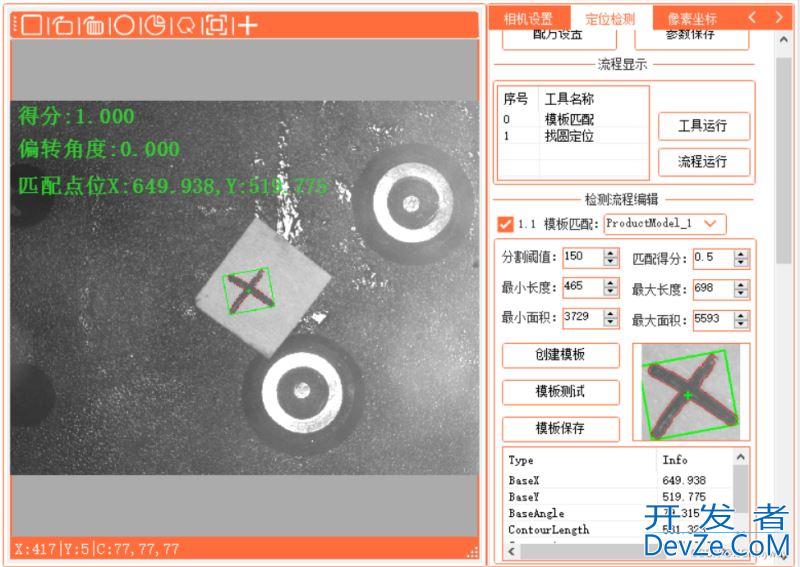
图1-1
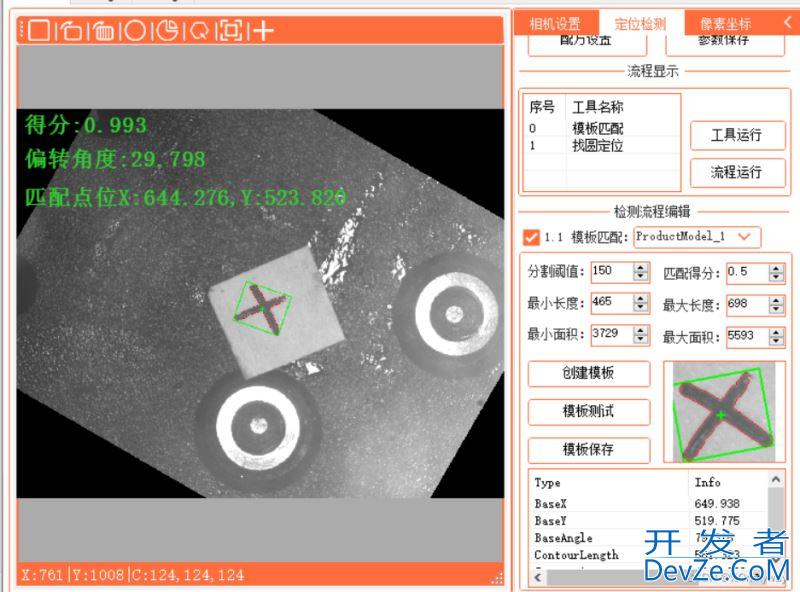
图1-2
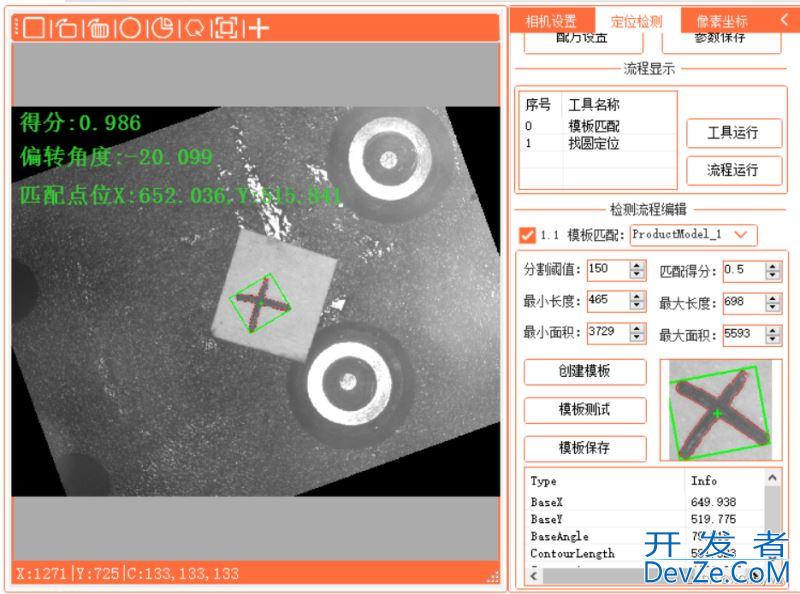
图1-3
正负角度均可正常识别,识别角度偏差<1°
2. 下面分享一下开发过程:
a). ROI区域的生成,基于GDI+完成图形绘制,如图
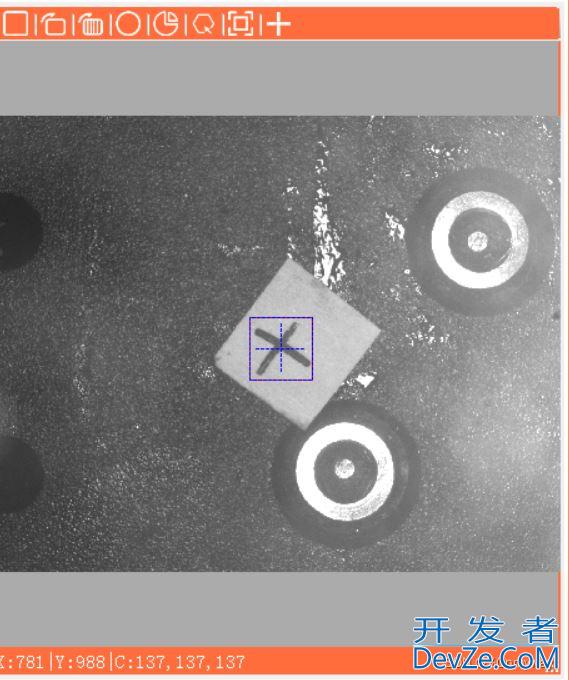
绘制模板设置区域,用来生成需要的模板特征。
ROI区域绘制代码如下:
/// <summary>
/// 区域绘制
/// </summary>
/// <param name="graphics"></param>
/// <param name="regionEx"></param>
/// <param name="sizeratio"></param>
public static void drawRegion(this Graphics graphics, RegionEx regionEx,float sizeratio=1)
{
if (regionEx?.Region is RectangleF)
{
RectangleF rect = (RectangleF)regionEx.Region;
graphics.DrawRectangle(new Pen(regionEx.Color, regionEx.Size), rect.X / sizeratio, rect.Y / sizeratio,
rect.Width / sizeratio, rect.Height / sizeratio);
}
else if(regionEx?.Region is RotatedRectF)
{
RotatedRectF rrect = (RotatedRectF)regionEx.Region;
using (var graph = new GraphicsPath())
{
PointF Center = new PointF(rrect.cx / sizeratio, rrect.cy / sizeratio);
graph.AddRectangle(new RectangleF( rrect.getrectofangleEqualZero().X / sizeratio,
rrect.getrectofangleEqualZero().Y / sizeratio,
rrect.getrectofangleEqualZero().Width / sizeratio,
rrect.getrectofangleEqualZero().Height / sizeratio));
graph.AddLine(new PointF((rrect.cx - rrect.Width / 2) / sizeratio, rrect.cy / sizeratio),
new PointF((rrect.cx + rrect.Width/2) / sizeratio, rrect.cy / sizeratio));
/
RotatedRectF rotatedRectF = new RotatedRectF((rrect.cx + rrect.Width / 2) / sizeratio,
rrect.cy / sizeratio,20 / sizeratio, 10 / sizeratio, 0);
PointF[] point2Fs = rotatedRectF.getPointF();
graph.AddLine(new PointF((rrect.cx + rrect.Width / 2) / sizeratio,
rrect.cy / sizeratio), new PointF(point2Fs[0].X, point2Fs[0].Y));
graph.AddLine(new PointF((rrect.cx + rrect.Width / 2) / sizeratio,
rrect.cy / sizeratio), new PointF(point2Fs[3].X, point2Fs[3].Y));
/
var a = rrect.angle * (Math.PI / 180);
var n1 = (float)Math.Cos(a);
var n2 = (float)Math.Sin(a);
var n3 = -(float)Math.Sin(a);
var n4 = (float)Math.Cos(a);
var n5 = (float)(Center.X * (1 - Math.Cos(a)) + Center.Y * Math.Sin(a));
var n6 = (float)(Center.Y * (1 - Math.Cos(a)) - Center.X * Math.Sin(a));
graph.Transform(new Matrix(n1, n2, n3, n4, n5, n6));
graphics.Drawpath(new Pen(regionEx.Color, regionEx.Size), graph);
}
}
else if (regionEx?.Region is RotatedCaliperRectF)
{
RotatedCaliperRectF rrect = (RotatedCaliperRectF)regionEx.Region;
using (var graph = new GraphicsPath())
{
PointF Center = new PointF(rrect.cx / sizeratio, rrect.cy / sizeratio);
graph.AddRectangle(new RectangleF(rrect.getrectofangleEqualZero().X / sizeratio,
rrect.getrectofangleEqualZero().Y / sizeratio,
rrect.getrectofangleEqualZero().Width / sizeratio,
rrect.getrectofangleEqualZero().Height / sizeratio));
graph.AddLine(new PointF((rrect.cx - rrect.Width / 2) / sizeratio, rrect.cy / sizeratio),
new PointF((rrect.cx + rrect.Width / 2) / sizeratio, rrect.cy / sizeratio));
/
RotatedCaliperRectF rotatedRectF = new RotatedCaliperRectF((rrect.cx + rrect.Width / 2) / sizeratio,
rrect.cy / sizeratio, 20 / sizeratio, 10 / sizeratio, 0);
PointF[] point2Fs = rotatedRectF.getPointF();
graph.AddLine(new PointF((rrect.cx + rrect.Width / 2) / sizeratio,
rrect.cy / sizeratio), new PointF(point2Fs[0].X, point2Fs[0].Y));
graph.AddLine(new PointF((rrect.cx + rrect.Width / 2) / sizeratio,
rrect.cy / sizeratio), new PointF(point2Fs[3].X, point2Fs[3].Y));
/
var a = rrect.angle * (Math.PI / 180);
var n1 = (float)Math.Cos(a);
var n2 = (float)Math.Sin(a);
var n3 = -(float)Math.Sin(a);
var n4 = (float)Math.Cos(a);
var n5 = (float)(Center.X * (1 - Math.Cos(a)) + Center.Y * Math.Sin(a));
var n6 = (float)(Center.Y * (1 - Math.Cos(a)) - Center.X * Math.Sin(a));
graph.Transform(new Matrix(n1, n2, n3, n4, n5, n6));
graphics.DrawPath(new Pen(regionEx.Color, regionEx.Size), graph);
}
}
else if (regionEx?.Region is CircleF)
{
CircleF circle = (CircleF)regionEx.Region;
graphics.DrawEllipse(new Pen(regionEx.Color, regionEx.Size), (circle.Centerx - circle.Radius) / sizeratio,
(circle.Centery - circle.Radius) / sizeratio, 2 * circle.Radius / sizeratio, 2 * circle.Radius / sizeratio);
}
else if (regionEx?.Region is PointF)
{
PointF point = (PointF)regionEx.Region;
graphics.DrawPolygon(new Pen(regionEx.Color, regionEx.Size), new PointF[] { new PointF (
point.X/sizeratio,point.Y/sizeratio
)});
}
else if (regionEx?.Region is PolygonF)
{
PolygonF polygon = (PolygonF)regionEx.Region;
List<PointF> temlist = new List<PointF>();
foreach (var s in polygon.Points)
temlist.Add(new PointF(s.X / sizeratio, s.Y / sizeratio));
graphics.DrawPolygon(new Pen(regionEx.Color, regionEx.Size), temlist.ToArray());
}
else if (regionEx?.Region is LineF)
{
LineF line = (LineF)regionEx.Region;
graphics.DrawLine(new Pen(regionEx.Color, regionEx.Size), line.x1/ sizeratio, line.y1/ sizeratio,
line.x2/ sizeratio, line.y2/ sizeratio);
}
else if (regionEx?.Region is CrossF)
{
CrossF cross = (CrossF)regionEx.Region;
graphics.DrawLine(new Pen(regionEx.Color, regionEx.Size), (cross.x1- cross.width/2) / sizeratio, cross.y1 / sizeratio,
(cross.x1 + cross.width / 2) / sizeratio, cross.y1 / sizeratio);
graphics.DrawLine(new Pen(regionEx.Color, regionEx.Size), cross.x1 / sizeratio, (cross.y1- cross.height/2) / sizeratio,
cross.x1 / sizeratio, (cross.y1 + cross.height / 2) / sizeratio);
graphics.DrawEllipse(new Pen(regionEx.Color, regionEx.Size), (cross.x1 - cross.radius) / sizeratio,
(cross.y1 - cross.radius) / sizeratio, 2 * cross.radius / sizeratio, 2 * cross.radius / sizeratio);
}
else if(regionEx?.Region is SectorF)
{
SectorF sectorF=(SectorF)regionEx.Region;
//graphics.DrawEllipse(MyPens.assist, sectorF.x / sizeratio, sectorF.y / sizeratio,
// sectorF.width / sizeratio, sectorF.height / sizeratio);
graphics.DrawPie(new Pen(regionEx.Color, regionEx.Size),
sectorF.x / sizeratio, sectorF.y / sizeratio,
sectorF.width / sizeratio, sectorF.height / sizeratio,
sectorF.startAngle, sectorF.sweepAngle);
}
else if (regionEx?.Region is Region)
{
Region unionRegion = (Region)regionEx?.Region;
//RectangleF rectangleF = unionRegion.GetBounds(graphics);
//Matrix matrix = new Matrix();
//matrix.Scale(1/sizeratio, 1/sizeratio);
//unionRegion.Transform(matrix);
//RectangleF rectangleF2= unionRegion.GetBounds(graphics);
graphics.FillRegion(Brushes.Orange, unionRegion);
}
else
;
}
b). 模板创建
模板如图:
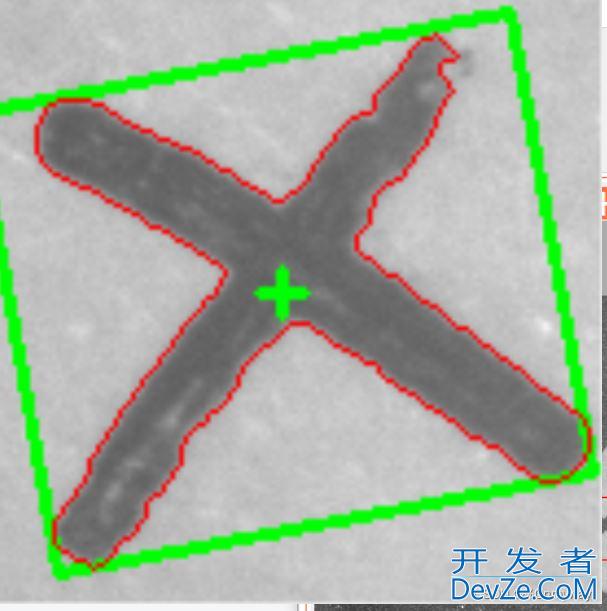
选择稳定唯一的形状特征,设置合适的参数,用来生成模板,此基础版生成的特征为闭合的轮廓,后期版本会推出非闭合的多轮廓形状匹配算法。
模板创建代码如下:
//创建模板
private void btncreateModel_Click(object sender, EventArgs e)
{
if (GrabImg == null || GrabImg.Width <= 0)
{
MessageBox.Show("未获取图像");
return;
}
List<RectangleF> roiList = currvisiontool.getRoiList<RectangleF>();
if (roiList.Count <= 0)
{
MessageBox.Show("请设置模板创建区域{矩形}");
return;
}
if (MessageBox.Show("确认创建新模板?", "Info", MessageBoxButtons.YesNo, MessageBoxIcon.Question)
== DialogResult.Yes)
{
CVRect cVRect = new CVRect((int)roiList[0].X, (int)roiList[0].Y, (int)roiList[0].Width, (int)roiList[0].Height);
Mat tp = MatExtension.Crop_Mask_Mat(GrabImg, cVRect);
templateContour = null;
coutourLen = 100;
NumMincoutourLen.Value=100;
contourArea = 100;
NumMinContourArea.Value=100;
double modelx = 0, modely = 0;
runTool = new ShapeMatchTool();
parmaData = new ShapeMatchData();
(parmaData as ShapeMatchData).Segthreshold = (double)NumSegthreshold.Value;
modeltp = (runTool as ShapeMatchTool).CreateTemplateContours(tp,
(parmaData as ShapeMatchData).Segthreshold, cVRect,
ref templateContour,
ref coutourLen, ref contourArea, ref modelx, ref modely, ref modelangle);
picTemplate.Image = BitmapConverter.ToBitmap(modeltp);
if (templateContour == null)
{
MessageBox.Show("模板创建失败!");
return;
}
modelx += cVRect.X;
modely += cVRect.Y;
lIstModelInfo.Items.Clear();
lIstModelInfo.Items.Add(new ListViewItem(
new string[] { "BaseX", modelx.ToString("f3") }));
lIstModelInfo.Items.Add(new ListViewItem(
new string[] { "BaseY", modely.ToString("f3") }));
lIstModelInfo.Items.Add(new ListViewItem(
new string[] { "BaseAngle", modelangle.ToString("f3") }));
lIstModelInfo.Items.Add(new ListViewItem(
new string[] { "ContourLength", coutourLen.ToString("f3") }));
lIstModelInfo.Items.Add(new ListViewItem(
new string[] { "ContourArea", contourArea.ToString("f3") }));
modelOrigion = string.Format("{0},{1},{2}",
modelx.ToString("f3"),
modely.ToString("f3"),
modelangle.ToString("f3"));
if(coutourLen * 0.8> (double)NumMincoutourLen.Maximum||
contourArea * 0.8> (double)NumMinContourArea.Maximum)
{
MessageBox.Show("模板创建完成失败,模板区域过大!");
return;
}
NumMincoutourLen.Value = (decimal)(coutourLen *0.8);
NumMaxcoutourLen.Value = (decimal)(coutourLen *1.2);
NumMinContourArea.Value = (decimal)(contourArea * 0.8);
NumMaxContourArea.Value = (decimal)(contourArea * 1.2);
NumMatchValue.Value = (decimal)0.5;
MessageBox.Show("模板创建完成!");
}
}
c). 模板匹配
多角度轮廓匹配算法,同时通过钜来获取中心,和角度
//模板匹配
void TestModelMatch()
{
if (GrabImg == null编程 || GrabImg.Width <= 0)
{
stuModelMatchData.runFlag = false;
MessageBox.Show("未获取图像");
return;
}
if (templateContour == null)
{
stuModelMatchData.runFlag = false;
MessageBox.Show("模板不存在,请先创建模板!");
return;
}
runTool = new ShapeMatchTool();
parmaData = new ShapeMatchData();
(parmaData as ShapeMatchData).tpContour = templateContour;
(parmaData as ShapeMatchData).Segthreshold = (double)NumSegthreshold.Value;
(parmaData as ShapeMatchData).MatchValue = (double)NumMatchValue.Value;
(parmaData as ShapeMatchData).MincoutourLen = (int)NumMincoutourLen.Value;
(parmaData as ShapeMatchDpythonata).MaxcoutourLen = (int)NumMaxcoutourLen.Value;
www.devze.com (parmaData as ShapeMatchData).MinContourArea = (int)NumMinContourArea.Value;
(parmaData as ShapeMatchData).MaxContourArea = (int)NumMaxContourArea.Value;
(parmaData as ShapeMatchData).baseAngle = modelangle;
ResultOfToolRun = runTool.Run<ShapeMatchData>(GrabImg, parmaData as ShapeMatchData);
currvisiontool.clearAll();
currvisiontool.dispImage(ResultOfToolRun.resultToShow);
ShapeMatchResult shapeMatchResult = ResultOfToolRun as ShapeMatchResult;
if (shapeMatchResult.scores.Count <= 0)
{
currvisiontool.DrawText(new TextEx("模板匹配失败!") {x=1000,y=10, brush = new SolidBrush(Color.Red) });
currvisiontool.AddTextBuffer(new TextEx("模板匹配失败!") { x = 1000, y = 10, brush = new SolidBrush(Color.Red) });
stuModelMatchData.runFlag = false;
return;
}
currvisiontool.DrawText(new TextEx("得分:" + shapeMatchResult.scores[0].ToString("f3")));
currvisiontool.AddTextBuffer(new TextEx("得分:" + shapeMatchResult.scores[0].ToString("f3")));
currvisiontool.DrawText(new TextEx("偏转角度:" + shapeMatchResult.rotations[0].ToString("f3")) { x = 10, y = 100 });
currvisiontool.AddTextBuffer(new TextEx("偏转角度:" + shapeMatchResult.rotations[0].ToString("f3")) { x = 10, y = 100 });
currvisiontool.DrawText(new TextEx(string.Format("匹配点位X:{0},Y:{1}", shapeMatchResult.positions[0].X.ToString("f3"),
shapeMatchResult.positions[0].Y.ToString("f3")))
{ x = 10, y = 200 });
currvisiontool.AddTextBuffer(new TextEx(string.Format("匹配点位X:{0},Y:{1}", shapeMatchResult.positions[0].X.ToString("f3"),
shapeMatchResult.positions[0].Y.ToString("f3")))
{ x = 10, y = 200 });
stuModelMatchData.matchPoint = shapeMatchResult.positions[0];
stuModelMatchData.matchOffsetAngle = shapeMatchResult.rotations[0];
stuModelMatchData.matchScore = shapeMatchResult.scores[0];
stuModelMatchData.runFlag = true;
}
3. 关键部位代码如下,包含模板创建,模板多角度匹配等
a)创建形状轮廓模板核心代码如下:
/// <summary>
/// 创建形状轮廓模板
/// </summary>
/// <param name="img_template">模板图像</param>
/// <param name="Segthreshold">分割阈值</param>
/// <param name="templateContour">模板轮廓</param>
/// <param name="coutourLen">模板轮廓长度</param>
/// <param name="contourArea">模板轮廓面积</param>
/// <param name="modelx">模板轮廓X</param>
/// <param name="modely">模板轮廓Y</param>
/// <param name="modelangle">模板轮廓角度</param>
/// <returns>返回绘制图</returns>
public Mat CreateTemplateContours(Mat img_template,double Segthreshold, CVRect boundingRect,
ref CVPoint[] templateContour, ref double coutourLen, ref double contourArea,
ref double modelx,ref double modely,ref double modelangle)
{
//灰度化
//Mat gray_img_template = new Mat();
//Cv2.CvtColor(img_template, gray_img_template, ColorConversionCodes.BGR2GRAY);
//阈值分割
Mat thresh_img_template = new Mat();
Cv2.Threshold(img_template, thresh_img_template, Segthreshold, 255, ThresholdTypes.Binary);
//开运算处理,提出白色噪点
Mat ellipse = Cv2.GetStructuringElement(MorphShapes.Ellipse, new Size编程客栈(3, 3));
Cv2.MorphologyEx(thresh_img_template, thresh_img_template, MorphTypes.Open, ellipse);
//Mat cannyMat = new Mat();
//Cv2.Canny(thresh_img_template, cannyMat, Segthreshold, 255);
//寻找边界
CVPoint[][] contours_template;
//Vector<Vector<CVPoint>> contours_template=new Vector<Vector<CVPoint>>();
//Vector<Vec4i> hierarchy=new Vector<Vec4i>();
// HierarchyIndex[] hierarchy;
Cv2.FindContours(thresh_img_template, out contours_template, out _, RetrievalModes.Tree,
ContourApproximationModes.ApproxNone);
CVPoint[][] ExceptContours = ContourOperate.ExceptBoundPoints(img_template.BoundingRect(), contours_template);
int count = ExceptContours.ToList<CVPoint[]>().Count;
List<CVPoint[]> ModelContours=new List<CVPoint[]>();
for (int i=0;i< count; i++)
{
if(Cv2.ContourArea(ExceptContours[i])>= contourArea&&
Cv2.ArcLength(ExceptContours[i],false)>= coutourLen)
//if (ExceptContours[i].Length > 30)//至少30点有效
ModelContours.Add(ExceptContours[i]);
}
ModelContours = ModelContours.OrderByDescending(s => s.Length).ToList();
//绘制边界
Mat dst = new Mat();
Cv2.CvtColor(img_template, dst, ColorConversionCodes.GRAY2BGR);
if(ModelContours.Count>0)
{
Cv2.DrawContours(dst, ModelContours, 0, new Scalar(0, 0, 255));
//获取重心点
Moments M;
M = Cv2.Moments(ModelContours[0]);
double cX = (M.M10 / M.M00);
double cY = (M.M01 / M.M00);
float a = (float)(M.M20 / M.M00 - cX * cX);
float b = (float)(M.M11 / M.M00 - cX * cY);
float c = (float)(M.M02 / M.M00 - cY * cY);
//计算角度(0~180)
// double tanAngle = Cv2.FastAtan2(2 * b, (a - c)) / 2;
//计算角度2(-90~90)
// double ang = (Math.Atan2(2 * b, (a - c)) * 180 / Math.PI) / 2;
//double ang2= Cv2.MinAreaRect(ModelContours[0]).Angle;
//if (tanAngle > 90)
// tanAngle -= 180;
//当前轮廓旋转矩
RotatedRect currrect = Cv2.MinAreaRect(ModelContours[0]);
//绘制旋转矩形
dst.DrawRotatedRect(currrect, Scalar.Lime);
//绘制目标边界
Cv2.DrawContours(dst, ModelContours, 0, new Scalar(0, 0, 255));
//显示目标中心
dst.drawCross(new CVPoint((int)cX, (int)cY),
new Scalar(0, 255, 0), 10, 2);
//
//CVPoint[] HullP = Cv2.ConvexHull(ModelContours[0], true);//顺时针方向
//List<CVPoint[]> HullPList = new List<CVPoint[]>();
//HullPList.Add(HullP);
Cv2.Polylines(dst, HullPList, true, Scalar.Red);
//Point2f cVPoint = CalBestDisP(new Point2d(cX, cY), HullP);
//double ang3 = ang;
//if(!(cVPoint.X==0&& cVPoint.Y == 0))
// {
// //计算角度2(-180~180)
// ang3 = calAngleOfLx(cX, cY, cVPoint.X, cVPoint.Y);
// Cv2.Line(dst, (int)cX, (int)cY, (int)cVPoint.X, (int)cVPoint.Y, Scalar.DarkOrange);
//}
//轮廓点位
modelx = cX;
modely = cY;
modelangle = currrect.Angle;
//轮廓长度
coutourLen = Cv2.ArcLength(ModelContours[0],false);
contourArea = Cv2.ContourArea(ModelContours[0]);
templateContour = ModelContours[0];
}
else
{
//轮廓点位
modelx = 0;
modely = 0;
modelangle = 0;
//轮廓长度
coutourLen = 0;
contourArea = 0;
templateContour =null;
}
return dst;
}
b)形状多角度匹配核心算法如下:
/// <summary>
/// 形状匹配
/// </summary>
/// <param name="image">输入图像</param>
/// <param name="imgTemplateco开发者_JS开发ntours">模板轮廓</param>
/// <param name="Segthreshold">分割阈值</param>
/// <param name="MatchValue">匹配值</param>
/// <param name="MincoutourLen">轮廓最小长度</param>
/// <param name="MaxcoutourLen">轮廓最大长度</param>
/// <param name="MinContourArea">轮廓最小面积</param>
/// <param name="MaxContourArea">轮廓最大面积</param>
/// <param name="shapeMatchResult">匹配结果</param>
/// <param name="isMultipleTemplates">是否使用多模板</param>
/// <returns>返回绘制图</returns>
bool ShapeTemplateMatch(Mat image, CVPoint[] imgTemplatecontours, double Segthreshold,
double MatchValue, int MincoutourLen, int MaxcoutourLen,
double MinContourArea, double MaxContourArea, double baseAngle,
ref ShapeMatchResult shapeMatchResult,
bool isMultipleTemplates=false)
{
//List<Point2d> image_coordinates = new List<Point2d>();
//灰度化
//Mat gray_img=new Mat();
//Cv2.CvtColor(image, gray_img, ColorConversionCodes.BGR2GRAY);
Mat dst = new Mat();
Cv2.CvtColor(image, dst, ColorConversionCodes.GRAY2BGR);
//阈值分割
Mat thresh_img = new Mat();
Cv2.Threshold(image, thresh_img, Segthreshold, 255, ThresholdTypes.Binary);
#region------此处增加与模板创建时候同样的图像处理--------
//开运算处理,提出白色噪点
Mat ellipse = Cv2.GetStructuringElement(MorphShapes.Ellipse, new Size(3, 3));
Cv2.MorphologyEx(thresh_img, thresh_img, MorphTypes.Open, ellipse);
#endregion
//Mat cannyMat = new Mat();
//Cv2.Canny(thresh_img, cannyMat, Segthreshold, 255);
//寻找边界
CVPoint[][] contours_img;
//HierarchyIndex[] hierarchy;
Cv2.FindContours(thresh_img, out contours_img, out _, RetrievalModes.Tree,
ContourApproximationModes.ApproxNone);
//根据形状模板进行匹配
int min_pos = -1;
double min_value = MatchValue;//匹配分值
List<CVPoint[]> points = contours_img.ToList<CVPoint[]>();
//List<double> angleList = new List<double>();
for (int i = 0; i < points.Count; i++)
{
//计算轮廓面积,筛选掉一些没必要的小轮廓
if (Cv2.ContourArea(contours_img[i]) < MinContourArea ||
Cv2.ContourArea(contours_img[i]) > MaxContourArea)
continue;
//轮廓长度不达标
if (Cv2.ArcLength(contours_img[i], false) < MincoutourLen ||
Cv2.ArcLength(contours_img[i], false) > MaxcoutourLen)
continue;
//得到匹配分值 ,值越小相似度越高
double value = Cv2.MatchShapes(contours_img[i], imgTemplatecontours,
ShapeMatchModes.I3, 0.0);
value = 1 - value;
//将匹配分值与设定分值进行比较
if (value >= min_value)
{
min_pos = i;
//将目标的得分都存在数组中
shapeMatchResult.scores.Add(value);
//匹配到的轮廓
shapeMatchResult.contours.Add(contours_img[min_pos]);
/*----------------*/
}
}
/*----------------*/
int count = shapeMatchResult.scores.Count;
if(count<=0)
{
shapeMatchResult.resultToShow = dst;
shapeMatchResult.exceptionInfo = "模板匹配失败!";
return false;
}
if (isMultipleTemplates)
{
for (int j = 0; j < count; j++)
{
//绘制目标边界
Cv2.DrawContours(dst, shapeMatchResult.contours, j, new Scalar(0, 0, 255));
//得分绘制
Cv2.PutText(dst,
string.Format("Score:{0};Angle:{1}", shapeMatchResult.scores[j].ToString("F3"),
shapeMatchResult.rotations[j].ToString("F3")),
//anglebuf[j].ToString("F3")),
new CVPoint(shapeMatchResult.contours[j][0].X + 10, shapeMatchResult.contours[j][0].Y - 10),
HersheyFonts.HersheyDuplex, 1, Scalar.Yellow);
//显示目标中心并提取坐标点
dst.drawCross(new CVPoint((int)shapeMatchResult.positions[j].X, (int)shapeMatchResult.positions[j].Y),
new Scalar(0, 255, 0), 10, 2);
//当前轮廓旋转矩
RotatedRect currrect = Cv2.MinAreaRect(shapeMatchResult.contours[j]);
dst.DrawRotatedRect(currrect, Scalar.Lime);
}
}
else
{
double bestScore= shapeMatchResult.scores.Max(); //最佳得分
int index = shapeMatchResult.scores.FindIndex(s=>s== bestScore);
// double bestangle = shapeMatchResult.rotations[index]; //最佳角度
// Point2d bestpos = shapeMatchResult.positions[index]; //最佳点位
CVPoint[] bestcontour= shapeMatchResult.contours[index]; //最佳轮廓
//绘制目标边界
Cv2.DrawContours(dst, shapeMatchResult.contours, index, new Scalar(0, 0, 255));
//获取重心点
Moments M = Cv2.Moments(bestcontour);
double cX = (M.M10 / M.M00);
double cY = (M.M01 / M.M00);
float a = (float)(M.M20 / M.M00 - cX * cX);
float b = (float)(M.M11 / M.M00 - cX * cY);
float c = (float)(M.M02 / M.M00 - cY * cY);
//计算角度(0~180)
// double tanAngle = Cv2.FastAtan2(2 * b, (a - c)) / 2;
//angleList.Add(tanAngle);
//计算角度2(-90~90)
//double ang = (Math.Atan2(2 * b, (a - c)) * 180 / Math.PI) / 2;
#region----角度计算方式2---
//-90~90度
//由于先验目标最小包围矩形是长方形
//因此最小包围矩形的中心和重心的向量夹角为旋转
RotatedRect rect_template = Cv2.MinAreaRect(imgTemplatecontours);
RotatedRect rect_search = Cv2.MinAreaRect(bestcontour);
//两个旋转矩阵是否同向
float sign = (rect_template.Size.Width - rect_template.Size.Height) *
(rect_search.Size.Width - rect_search.Size.Height);
float angle=0;
http://www.devze.com if (sign > 0)
// 可以直接相减
angle = rect_search.Angle - rect_template.Angle;
else
angle = (90 + rect_search.Angle) - rect_template.Angle;
if (angle > 90)
angle -= 180;
#endregion
//显示目标中心并提取坐标点
dst.drawCross(new CVPoint((int)cX, (int)cY),
new Scalar(0, 255, 0), 10, 2);
//当前轮廓旋转矩
RotatedRect currrect = Cv2.MinAreaRect(bestcontour);
//绘制旋转矩形
dst.DrawRotatedRect(currrect, Scalar.Lime);
//CVPoint[] HullP = Cv2.ConvexHull(bestcontour, true);//顺时针方向
//List<CVPoint[]> HullPList = new List<CVPoint[]>();
//HullPList.Add(HullP);
//Cv2.Polylines(dst, HullPList, true, Scalar.Red);
//Point2f cVPoint = CalBestDisP(new Point2d(cX, cY), HullP);
//double ang3 = ang;
//if (!(cVPoint.X == 0 && cVPoint.Y == 0))
//{
// //计算角度2(-180~180)
// ang3 = calAngleOfLx(cX, cY, cVPoint.X, cVPoint.Y);
// Cv2.Line(dst, (int)cX, (int)cY, (int)cVPoint.X, (int)cVPoint.Y, Scalar.DarkOrange);
//}
//double offsetA = ang3 - baseAngle;//偏转角
//if (offsetA < -180)
// offsetA += 360;
//else if (offsetA > 180)
// offsetA -= 360;
//得分绘制
//Cv2.PutText(dst,
// string.Format("Score:{0};Angle:{1}", bestScore.ToString("F3"),
// ang3.ToString("F3")),
// new CVPoint(shapeMatchResult.contours[index][0].X + 10, shapeMatchResult.contours[index][0].Y - 10),
// HersheyFonts.HersheyDuplex, 1, Scalar.Yellow);
shapeMatchResult.positions.Clear();
shapeMatchResult.rotations.Clear();
shapeMatchResult.scores.Clear();
shapeMatchResult.contours.Clear();
//将目标的重心坐标都存在数组中
shapeMatchResult.positions.Add(new Point2d(cX, cY));//向数组中存放点的坐标
shapeMatchResult.rotations.Add(angle);//将偏转角度都存在数组中
shapeMatchResult.scores.Add(bestScore);//将目标的得分都存在数组中
shapeMatchResult.contours.Add(bestcontour); //匹配到的轮廓
/*----------------*/
}
shapeMatchResult.resultToShow = dst;
return true;
}
到此这篇关于C# OpenCV实现形状匹配的方法详解的文章就介绍到这了,更多相关C# OpenCV形状匹配内容请搜索我们以前的文章或继续浏览下面的相关文章希望大家以后多多支持我们!





 加载中,请稍侯......
加载中,请稍侯......
精彩评论